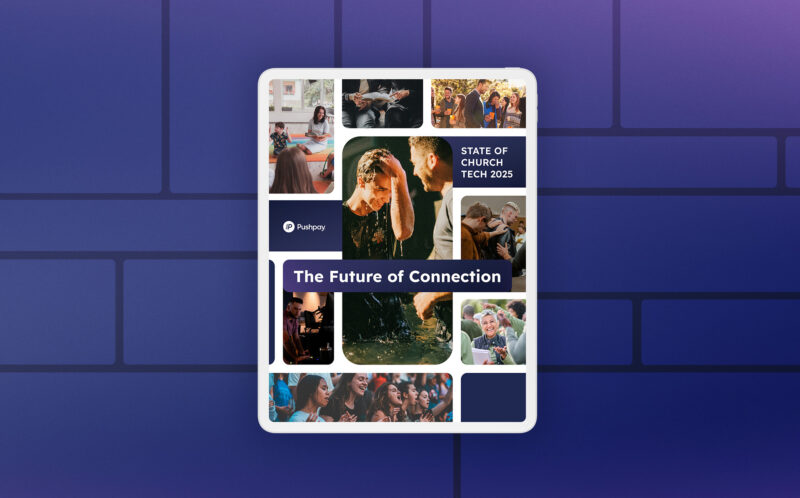
11 Donor Relationship Management Strategies That Keep Funds Flowing
How do you keep your donors happy and encourage giving? We have 11 donor relationship management strategies to quickly grow your church today!
Developing a donor relationship management strategy is vital to your church’s growth and sustainability. For most churches, if the biggest donors suddenly stopped giving, it could financially cripple the entire ministry.
Donor development is undeniably important, but it’s also a big staff commitment. Every donor’s journey is unique, and your staff often has to be very intentional about how they communicate with each donor if you want to maximize their giving potential.
TOUR PUSHPAY’S DONOR MANAGEMENT PLATFORM
What is donor relationship management?
Donor relationship management is the process of thoughtfully and proactively developing relationships with givers to foster stronger donor retention. The relationships with donors are crucial, whether you’re starting fresh with a new donor or stewarding current donors to maximize retention. By kicking off with a sound donor relations strategy supported by donor management software, building and maintaining your donor base doesn’t need to be complicated.
How do you build and maintain a strong relationship with donors?
A strong relationship with donors can’t be forced—but churches must facilitate it. Each church service, event, and email is a new opportunity to build and strengthen donor relationships. And strong relationships with your donors result in a stronger community, increased donations, and ultimately greater success in fulfilling your church’s mission.
There are two core ways you can start cultivating better donor relationships:
- Automate Donation Processes: To save time and maintain a personal touch, automate communications and donation processes. Utilizing technology, such as mobile giving platforms and donor management software, streamlines the donation process and optimizes the donor experience.
- Leverage Your Ministry Leaders: People want assurance that their contributions to a church will make a difference. While there may not be a clear financial return on investment, ministry leaders can collaborate to demonstrate the tangible impact of the congregation’s generosity. By sharing stories of transformed lives and the community impact achieved through various ministries, potential donors and regular givers can be inspired and see the value in investing in the church. Ministry leaders possess knowledge of their ministry’s significant achievements, which can be incorporated into email campaigns, blog posts, and content cards.
Plus, tools like Pushpay let you create specific funds your congregation can give to, so your ministry leaders can help build relationships with key donors who may be more interested in supporting a specific cause.
Even with a small team and limited time, developing a donor relations strategy makes it easy to incorporate donor development into the things you’re already doing.
TOUR PUSHPAY’S DONOR MANAGEMENT PLATFORM
What is a donor strategy?
A donor development strategy is something your church creates to make it easy to build better, longer-term relationship with donors. Donor relationship strategies are intentional, donor-focused, and look different at every church.
Your donors interact with your church in a variety of ways, and not just by donating. They:
- attend worship services
- register for events
- read your emails
- volunteer
- and share your mission with others
Spend time strengthening relationships in all aspects of your ministry, not just asking for donations. Taking steps to build meaningful connections will help your church grow and achieve its mission and can also help with donor prospecting and donor cultivation.
How do you create a donor relationship management strategy?
With the right strategies, maintaining a high donor retention rate is easy. The following 11 donor relationship management strategies will help you foster and maintain relationships so your church can thrive.
From encouraging donors to give for the first time to thanking recurring donors, you’ll have a strategy for every step of the giving journey to build a stronger relationship.
1 – Make A Strong First Impression
First impressions are crucial for new donors. Make barriers to getting connected and giving as low as possible. Create an emphasis within your teaching, culture, and operations around making that initial gift as easy as possible. And remove barriers for first-time donors by offering a simple, easy-to-use online giving option.
Digital transactions offer an unparalleled level of convenience, and it’s the type of experience people expect to have in today’s mobile world. Ultimately, mobile giving makes a good first impression. With Pushpay, first-time gifts only take 30 seconds—and if donors save their information, it’s even faster the second time.
2 – Use Donor Management Software
When you first start out in ministry and only have a few donors, it’s easy to keep data in a simple spreadsheet. But once your church grows and you have data for hundreds or thousands of donors, a spreadsheet just falls short. Before your data starts to snowball out of control, ensure you have the tech to keep donors organized, engaged, and connected to your ministry.
Church management software like Pushpay can host a database of your congregation, full of easy insights into donor history, engagement, and where givers are on their donor journey—all of which can inform how you should be connecting with your congregation, both individually and as a whole.
3 – Segment Your Audience
A key strategy to donor relationship building is knowing exactly who you’re talking to. Your community all have special—but different—connections to your ministry and mission. A first-time donor may be moved by your mission. A veteran donor trusts your church and wants to see it grow.
Each stage of the donor relationships needs unique motivations and messages, and segmentation allows you to do that. Start by organizing donors into categories like:
- First-time donors
- Recurring donors
- Giving levels (low-level, mid-level, or major donors)
- Donation frequency
- Seasonality of giving
4 – Personalize Communication
In a perfect world, every message to your donors would be personalized. And while that’s unrealistic, it doesn’t hurt to try. Donors are real people and want to be treated as such.
Wondering if personalization is worth it? Open and click-through rates are significantly higher for personalized emails! The extra time taken to personalize messages makes donors feel recognized and appreciated. They’re not just another name in a database, they’re a partner in your ministry.
Not sure you’re able to personalize messages? The backbone of personalization is data. You can collect a lot of data from your donors when they donate to your organization. But if there’s a piece of information that you still want from them, you can ask!
5 – Ask for Feedback
Always keep donor communication lines open. Everyone likes to feel heard, so asking for feedback is an easy strategy for churches to build a donor relationship. You don’t have to wonder what your donors think. You just have to ask the right questions, and they’ll tell you. This also keeps donor engagement at an all-time high.
You can ask donors almost anything:
- What do they think of your communication cadence?
- What led them to give to your ministry?
- How do they prefer to donate?
- How would they rate their donation experience?
- Do they feel like they know the impact of their gifts?
- What other causes are they passionate about or are currently supporting?
Asking existing donors these questions makes them feel heard and appreciated, strengthening your donor relationships. And collecting feedback gives your staff more insight so that you can reach out to donors more effectively in the future. It’s a win-win!
6 – Develop Nurture Campaigns
Keep your donors in the loop! Show them they’re more than just their wallets through regular, non-monetary communication. Automated nurturing messages can be anything—emails, text messages, videos, direct mail, and more. These messages can cover industry news, project updates, and important announcements.
And when you reach major milestones because of donations, your nurture campaigns can share your gratitude to donors for helping you reach your goal. Make sure they know you couldn’t do it without them.
Popping into donors’ inboxes or mailboxes with an inspiring message or relevant news, followed by an occasional request for a donation, strengthens your relationship with donors. You’ll be surprised at the impact nurture campaigns will have.
7 – Say Thank You Often
Saying thank you feels like an obvious follow-up to any donation, but it’s easy for that to fall through the cracks when you’re a busy church full of people who are always giving. Thanked donors are more engaged donors. And they’re more likely to give again and do more.
So what should the thank you message say? Let’s start with “thank you.” There, that was easy! You can also include how their gift impacts your organization. Don’t ask for more donations while thanking someone. Keep the message simple and focus on the giver, their donation, and the impact it has on your ministry.
Once you’ve crafted the “thank you” message, you need a way to share it. Most ministries use multiple platforms to thank donors, from emails, to texts, to messages within the church’s app. With Pushpay’s custom church app, you can send personalized thank you messages to donors based on the specific fund they donated to—all within a few minutes. However you do it, make a point of telling your congregation, “Thank you.”
When it comes to donor relationship management strategies, you’re not just saying “thank you.” You’re reinforcing your church’s values by taking the time to thank donors who have financially supported your church. You’re showing donors that generosity is appreciated and that you depend on their faithful giving. As a church, anything you intend to do in the future will be funded by new or existing donors. Maintaining a good relationship with people who have already given is critical. Thanking them is an easy strategy to put in place to help your relationships thrive.
8 – Use Giving Statements Frequently
Giving statements make it easy for your donors to see how much they’ve given so far this year. Surprisingly, people often assume they’ve given more than they actually have, So giving statements can be used as a donor relationship management strategy. If donors haven’t given as much as they planned, something like a quarterly giving statement can help donors reassess how much they’re giving so they can achieve their goal by the end of the year.
It’s normal for churches to dread organizing annual giving statements. Just the thought of the time spent folding papers, stuffing them into envelopes, licking those envelopes, stamping them, and mailing them out may make you feel exhausted! However, with digital giving statements, all of a sudden, they become a valuable (and convenient) opportunity to engage your donors. That engagement doesn’t have to be not just once a year, but bi-annually or even quarterly!
Pushpay allows donors to make a pledge, where they decide an amount they’d like to give by a specified time. Giving statements can include someone’s progress toward their pledge, providing a valuable reminder when someone’s giving falls behind.
9 – Demonstrate Donor Impact
One of the top reasons donors reconsider giving is because they do not clearly understand the impact of their fundraising efforts. The easiest way to respond is by providing tangible examples of how each donated dollar is spent. That way, your existing and prospective donors know how impactful their gift is.
Did their donation;
Buy a meal for a hungry child?
Pay for warm coats for the homeless in your community?
Help fund a mission trip halfway across the world?
Support the start of a new church campus to spread the gospel further?
Shine a spotlight on the direct impact your donors have. For example, you can give them encouraging updates through emails, app updates, or on-stage announcements on Sunday mornings. Including a quick photo of breaking ground on a new campus or a video of missionaries sharing the gospel directly shows your donors the impact they’re making.
Demonstrating the specific impact of donors’ gifts will make your donors feel good and build trust for your church. These work together to strengthen your donor relationships.
10 – Be Transparent
Just like personal relationships, a strong relationship between donors and churches comes down to trust. Donors need to trust your ministry’s work to stay involved and continue giving donations. And establishing trust starts with providing relevant and transparent information about your church’s finances.
If you were a donor and found out that an organization you supported financially was using your money for something contrary to their vision, you would probably be pretty upset. Churches have a responsibility to be, well, responsible!
Transparency is much more than an annual finance meeting or financial report. True transparency involves your congregation along the entire journey. Being transparent about your finances is one of the best donor relationship management strategies for real trust and continued growth with donors.
11 – Get Active on Social Media
Today, 72% of Americans use social media. Social media has shifted from a fun pastime to an essential part of a donor relationship management strategy. It provides an amazing way for your ministry to communicate with donors in real-time. Whichever platform you share ministry content on should be relevant to your mission and your audience.
Just like your other donor communications, social media needs to have more than donation appeals. Mix in engaging posts like conversation starters, thank yous, and impact reports. These posts can establish strong donor relationships while being relatable and transparent with potential donors. An active social media presence can enhance your ability to build impactful donor relationships as a nonprofit!
Which donor management strategy will you start with?
Donor base development isn’t a responsibility you can take lightly, and it doesn’t have an end date. As relationships grow deeper and last longer, donors become more engaged with your church, they continue to engage more, whether that’s in their giving, involvement, advocacy, or volunteering.
The question now is, which of these donor relationship management strategies will you try first?
And when you need support strengthening your donor relationship management, we’re here for you. All of Pushpay’s technology is built on the belief that mission-based organizations need a great donor management software, specifically designed to advance your ministries and ensure the success of your mission. Our donor management software also keeps donor information organized, and our church donation software makes online giving for churches simple. To learn more about how we can help your church—especially in regard to donor relationship management—schedule a call with one of our experts today.
Sources
https://nonprofitssource.com/online-giving-statistics/
https://www.learningtogive.org/resources/generation-z-and-philanthropy
https://www.pewresearch.org/internet/fact-sheet/social-media/





